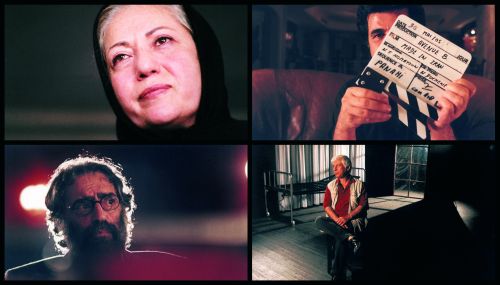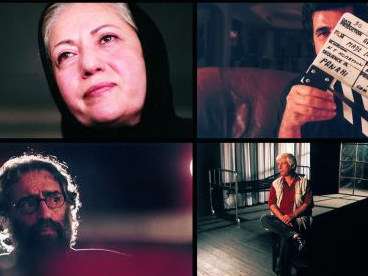Iran a cinematographic revolution
Data: 3.09.2018 / Rating: 4.8 / Views: 671Gallery of Video:
Gallery of Images:
Iran a cinematographic revolution
Telly addict Andrew Collins casts his critical eye over New Worlds (above), Klondike, The Trip to Italy, Endeavour and Monkey Planet. Iran: A Cinematographic Revolution (2006) Documentary; Today Iranian cinema is one of the most highly regarded national cinemas in the world, regularly winning festival awards and critical acclaim for films which combine remarkable artistry and social relevance. Iran: A Cinematographic Revolution traces the development of this film industry, which has always been closely intertwined with the country's tumultuous political history, from the decadeslong reign of Reza Shah Pahlevi and his son, the rise of Khomeini and the birth of the Islamic Republic, the seizure by militants of the U. Iran: A Cinematographic Revolution traces the development of this film industry, which has always been closely intertwined with the countrys tumultuous political history, from the decadeslong reign of Reza Shah Pahlevi and his son, the rise of Khomeini and the birth of the Islamic Republic, the seizure by militants of the U. Iran: A Cinematographic Revolution Be the first to review this item IMDb 7. 4 98 min 2006 NR Subtitles and Closed Captions A study of Iranian cinema one of the most highly regarded national cinemas in the world and its relation to the country s political and social milieu. 6: 00pm: Iran: A Cinematographic Revolution Dir Nader T Homayoun (2007), Iran. In Persian with English subtitles. Iran: A Cinematographic Revolution traces the development of Iranian film industry, which has always been closely intertwined with the countrys tumultuous political history, from the. Iran: A Cinematographic Revolution Produced for French television, pic looks to the roots of Iranian cinema history and draws a detailed portrait of a film culture molded by politics, religion. The Tomatometer rating based on the published opinions of hundreds of film and television critics is a trusted measurement of movie and TV programming quality for millions of moviegoers. Documentarian Nader Takmil Homayoun delivers a plenary eulogy to Persian cinema its fullest to date with Iran: Une Rvolution cinmatographique. Over the course of 98 minutes, Homayoun follows the evolution and shifting stylistic currents of Iranian film over the course of 70 years, as those. Ver pelcula Iran: A Cinematographic Revolution Online GRATIS Ver online la pelicula Iran: A Cinematographic Revolution en HD Pelicula Online Iran: A Cinematographic Revolution CASTELLANO LATINO en DePelis24. com 2018 Watch Iran: A Cinematographic Revolution on Movietube. Today Iranian cinema is one of the most highly regarded national cinemas in the world, regularly win In Iran: A Cinematographic Revolution, Nader Takmil Homayoun situates the development of Irans internationally acclaimed national cinema relative to the broad political, social, and religious. Iran: A Cinematographic Revolution traces the development of Iranian film industry, which has always been closely intertwined with the countrys tumultuous political history, from the decadeslong reign of Reza Shah Pahlevi and his son, the rise of Khomeini and the birth of the Islamic Republic, the seizure by militants of the US Embassy in. Submit data corrections for Iran: A Cinematographic Revolution Nader Takmil Homayoun on AllMovie Iran: A Cinematographic Revolution Today Iranian cinema is one of the most highly regarded national cinemas in the world, regularly winning festival awards and critical acclaim for films which combine remarkable artistry and social relevance. iran: a cinematographic revolution Nader T. Homayoun Throughout the twentieth century, Iranian filmmakers have been involved in a constant struggle, first. The intertwined history of Iran and its cinema, from the first silent films to the talkies, from the Shah's regime to the Islamic revolution, and the international cinematic success of today. Iran: A Cinematographic Revolution (2006) is a documentary movie starring Rakhshan BaniEtemad and Bahram Beizai. Today Iranian cinema is one of the most highly regarded national cinemas in the world, regularly winning festival awards and critical acclaim for films which combine remarkable. Click to latest reviews, trailer. Iran: A Cinematographic Revolution shows how closely the film industry in Iran has mapped, anticipated, and helped to shape the nations political movements and fractures. Watch movie Iran: A Cinematographic Revolution online on Putlocker. Today Iranian cinema is one of the most highly regarded national cinemas in the w . Watch Iran: A Cinematographic Revolution (2006) Free Online Today Iranian cinema is one of the most highly regarded national cinemas in the world, regularly winning festival awards and critical acclaim for films which combine remarkable artistry and social relevance. Bypass the box office line at many theaters with guaranteed tickets. If something comes up, you can return or exchange up to two hours before showtime through Fandango. Watch Iran: A Cinematographic Revolution 2006 Movie on Putlocker Free Online. Today Iranian cinema is one of the most highly regarded national cinemas In Iran: A Cinematographic Revolution, Nader Takmil Homayoun situates the development of Irans internationally acclaimed national cinema relative to the broad political, social, and religious events that conditioned it, from the midSixties to the present. The strength of this remarkable. Iran: A Cinematographic Revolution Directed by Nader Takmil Kandahar A rounded and robust overview of Iranian cinema and its shifting relationship to the political and religious tides in. IRAN: A CINEMATOGRAPHIC REVOLUTION traces the development of this film industry, which has always been closely intertwined with the country's tumultuous political history, from the decadeslong reign of Reza Shah Pahlevi and his son, the rise of Khomeini and the birth of the Islamic Republic, the seizure by militants of the U. In Iran: A Cinematographic Revolution, Nader Takmil Homayoun situates the development of Irans internationally acclaimed national cinema relative to the broad political, social, and religious events that conditioned it, from the midSixties to the present. The strength of this remarkable documentary lies in its strategy of using the history of the image as a means of exploring the shaping of. [fontCentury GothicIran: A Cinematographic Revolution is a fascinating documentary about the history of Iranian filmmaking, starting with The Cinema Actor in 1933. Iran: A Cinematographic Revolution Director: Nader Takmil Homayoun First RunIcarus Films 98 mins. In Iran: A Cinematographic Revolution, Nader Takmil Homayoun situates the development of Irans internationally acclaimed national cinema relative to the broad political social and religious events that conditioned it, from the midsixties to the present. Director: Nader Takmil Homayoun. In Iran: A Cinematographic Revolution, Nader Takmil Homayoun situates the development of Irans internationally acclaimed national cinema relative to the broad political social and religious events that conditioned it, from the midsixties to the present. Iran: a cinematographic revolution. [Nader T Homayoun; Traces the history of Iranian cinema from the era of the Shah, through the revolution and the IranIraq war, to contemporary times. Features archival material, film excerpts and expert interviews. This doc explores the history of the Iranian film industry through a compelling blend of archival footage, film excerpts, and interviews with film makers, critics, and historians revealing the changing social functions of Iranian cinema and the artistic struggle of its creators. Iran: A Cinematographic Revolution traces the development of this film industry, which has always been closely intertwined with the country's tumultuous political history, from the decadeslong reign of Reza Shah Pahlevi and his son, the rise of Khomeini and the birth of the Islamic Republic, the seizure by militants of the U. Arts Documentary directed by Nader Takmil Homayoun and published by Arte in 2006 English narration [ Cover[ InformationToday Iranian cinema is one of the most highly regarded national cinemas in the world, regularly winning festival awards and critical acclaim for films which combine remarkable artistry and social relevance. Iran: A Cinematographic Revolution traces the development of this film industry, which has always been closely intertwined with the countrys tumultuous political history, from the decadeslong reign of Reza Shah Pahlevi and his son, the rise of Khomeini and the birth of the Islamic Republic, the seizure by militants of the U. Despite political turmoil and cultural isolation and sometimes even because of them Iran has served as fertile ground for filmmakers for more than seven decades, as witnessed by this tribute to Persian cinema from Nader Takmil Homayoun. Iran: A Cinematographic Revolution is a decent overview of the film industry in Iran. Unfortunately, a LOT has happened since then and the documentary unintentionally gives you a. This documentary explores Iran's cinematic history through a compelling blend of archival footage, excerpts from representative and landmark Iranian films, and interviews with Iranian filmmakers, film critics, film historians, and government and film industry executives. Iran: Une Rvolution cinmatographique traces the evolution of Iranian film and its relation to the countrys political and social milieu. A dazzling array of film clips is intercut with remarkable archival footage of Iran during periods of both war and peace. Iran: A Cinematographic Revolution, originally produced in French, traces the inexorable relationship between Irans film history and its political history. Through interviews with Iranian filmmakers, film critics, government and film industry executives it puts forth a. Iran: A Cinematographic Revolution Nader Homoyoun (2007) When the Islamic revolution took place? It was the overthrow of the Pahlavi dynasty, lead by Ayatollah Khomeini who became the religious supreme leader replacing the dynasty with an Islamic republic. IRAN: A CINEMATOGRAPHIC REVOLUTION traces the development of this film industry, which has always been closely intertwined with the country's tumultuous political history, from the decadeslong. Iran A Cinematographic Revolution Directed by Nader Takmil Homayoun Today Iranian cinema is one of the most highly regarded national cinemas in the world, regularly winning festival awards and critical acclaim for films that combine remarkable artistry and social relevance.
Related Images:
- Soundtrack city of angels
- Magdalene sisters 2002
- Blades and time
- Dragon ball z 200
- The garden st
- Opticut
- Hot and mean mack
- Secrets of secret service
- Episodes Season 2 Complete
- 34 number ones
- Jack zipes breaking the disney spell pdf
- American tail treasure
- Artie lange roast
- Vision Future Framework Standards Impairment
- Injustice gods among us year two 023
- Nikki benz jess
- Michael jordans playground
- Bocij business information systems pdf
- 9 9 0 9
- John cooper clark
- Barbie e la pop star
- Trois couleurs Blanc
- Toppers in concert
- Imagine dragons radioactive lamar
- Parks recreation 720p s06e07
- Fifa world cup 2018 belgi
- Serie griffin ita
- Haider 2014 hindi movie
- The signal bl
- Ultimate power ballads
- Bs en 60617 electrical symbols pdf
- Last airbender dual
- The Lawrence welk show
- Season 8 southpar
- Security analysis 2nd edition
- The shield s01e03
- Lana del rey summertime sadness
- A bite of china s02e03
- Psycho pass flac
- All ultimates 2018
- I made that
- Philip glass flac
- Jack and jill spanish
- Till i die
- Dvdrip sub esp 2018
- David bowie absolute beginners
- Iq the wake
- All stars ps2
- Subway Surfers sydney
- Final destination 2 1080p
- 2013 formula 1 malaysia race
- A walk among the tombstones kor
- Artificial intelligence books
- Criminal Minds s10e01 720p
- Riddick the dark
- Pacos Story
- Safe house 720p
- Bsc practical physics geeta sanon
- Bba beck bogert appice
- Router Keygen Apk Full
- Sword art online 720 04
- Jessie st james
- 009 the beginning of the end
- Big Bang Theory 6th Season
- Inside the secret world of muammar
- Best movie scene
- The midsummer station owl city
- Nordictrack Sl720
- The real mill
- Furious 6 2018 extended 1080p brrip
- Nba rs 2011












